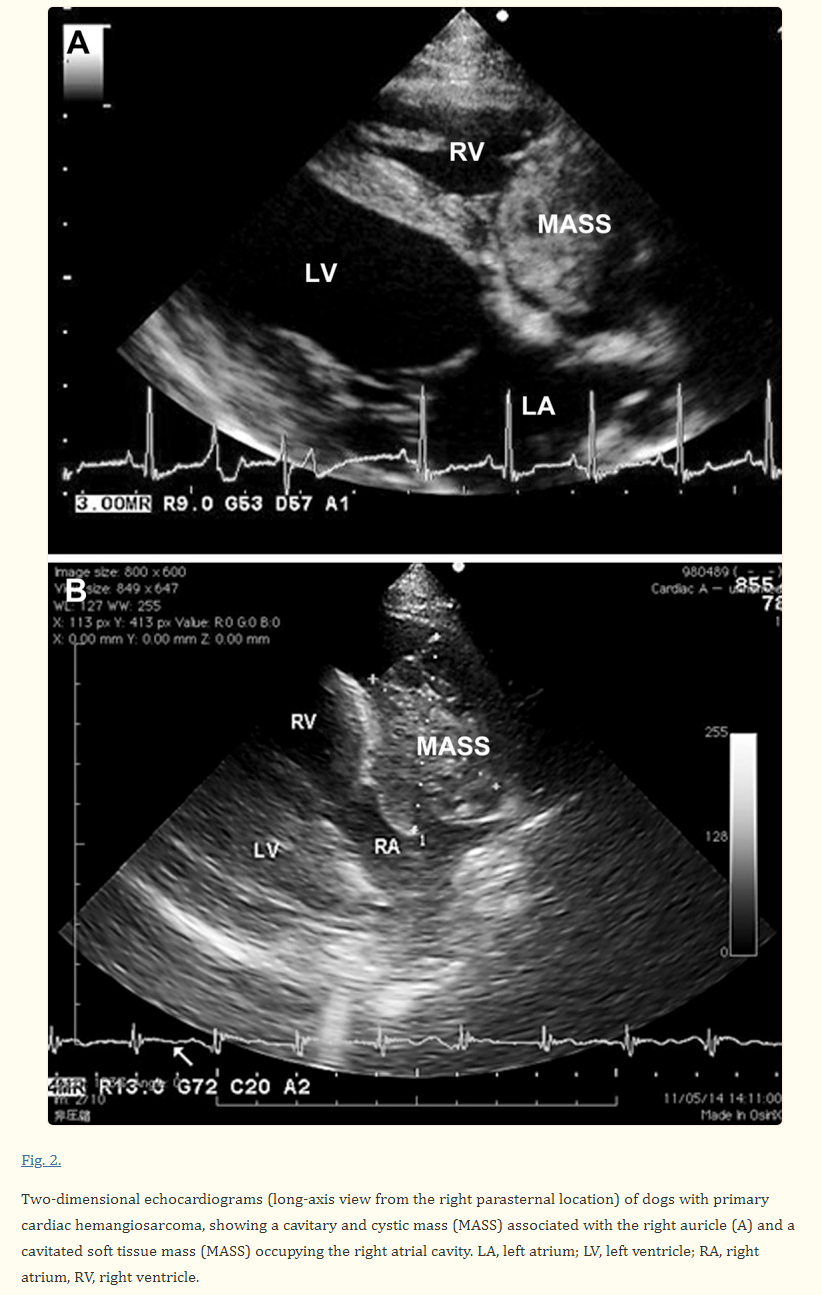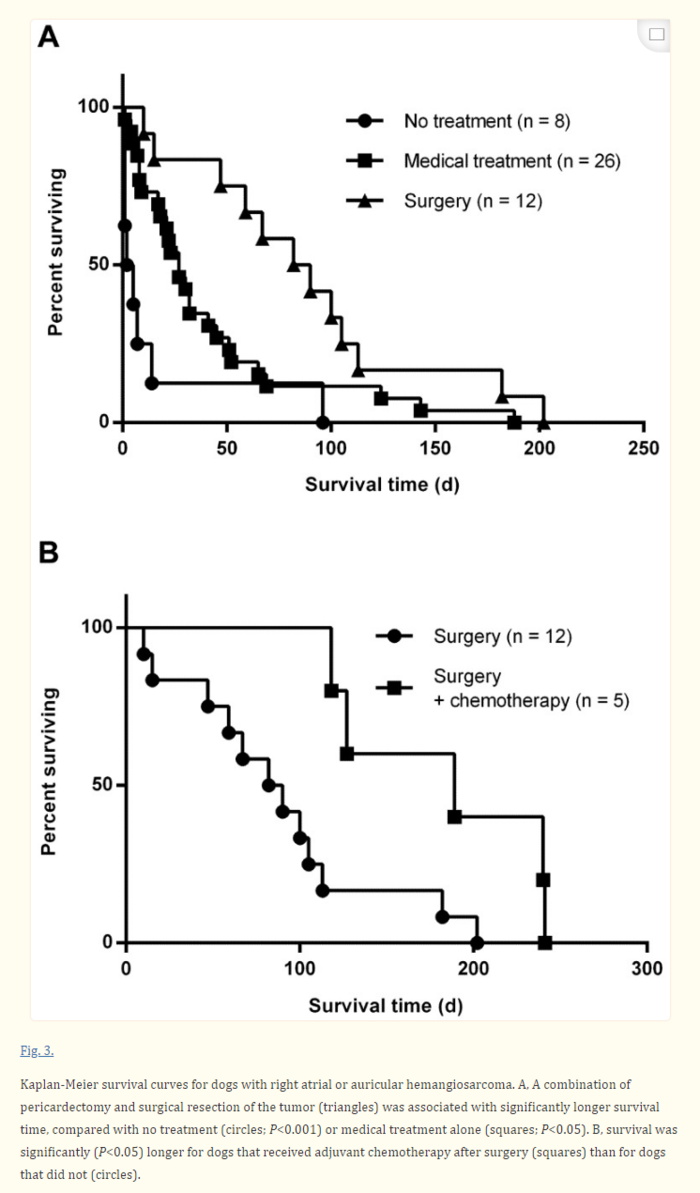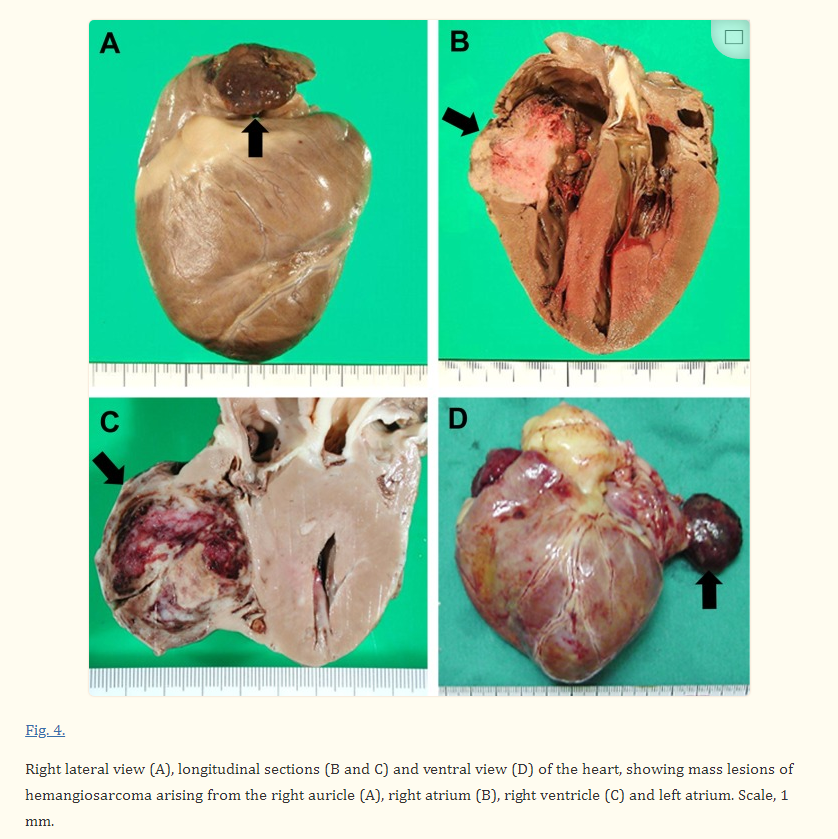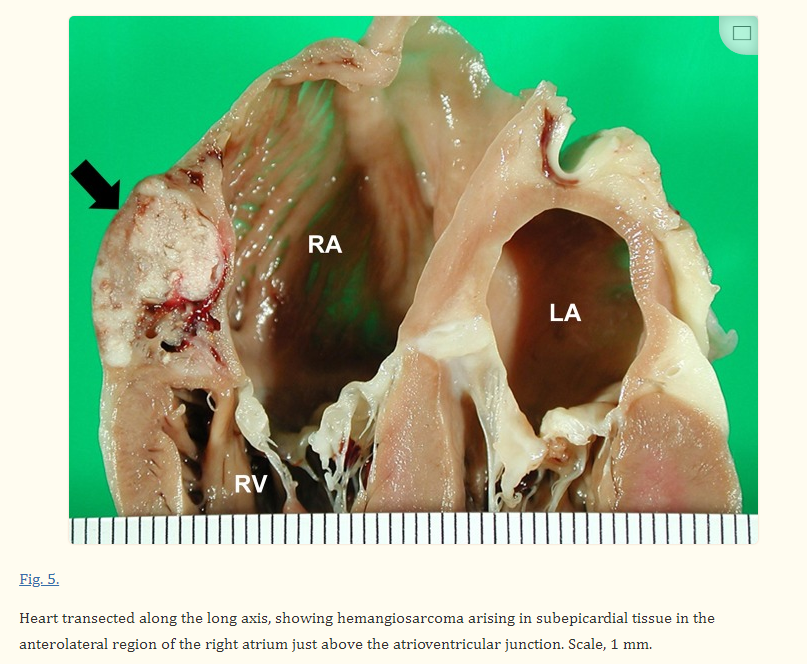狗狗原发性心脏血管肉瘤的流行病学、临床和病理特征:51例的回顾
(→结论 (Results)) |
(→结论 (Results)) |
||
| 第7行: | 第7行: | ||
== 结论 (Results) == | == 结论 (Results) == | ||
| − | '''信号''':参加本研究的狗的品种包括:GR(11 | + | '''信号''':参加本研究的狗的品种包括:GR(11 只狗);马耳他语 (9);混种 (8);微型腊肠犬 (7);拉布拉多猎犬 (3);威尔士柯基犬彭布罗克(3);西伯利亚雪橇犬 (2);以下各一种:博美犬;约克夏梗;西施犬;杰克罗素梗;设得兰牧羊犬;比格;边境牧羊犬;和 GS(表 1)。平均年龄为10.7岁±2.8岁(范围为5至16岁)。男性占病例的63%(32/51),女性占37%(19/51)(表1)。平均体重为 16.5 ± 11.6 公斤(范围为 2.5 至 40 公斤)。 |
'''Signalment''': The breeds of the dogs enrolled in this study included: GR (11 dogs); Maltese (9); mixed-breed (8); Miniature Dachshund (7); Labrador Retriever (3); Welsh Corgi Pembroke (3); Siberian Husky (2); and one each of the following: Pomeranian; Yorkshire Terrier; Shih Tzu; Jack Russell Terrier; Shetland Sheepdog; Beagle; Border Collie; and GS (Table 1). The mean age was 10.7 ± 2.8 years (range, 5 to 16 years). Males accounted for 63% (32/51) of the cases and females for 37% (19/51) (Table 1). The mean body weight was 16.5 ± 11.6 kg (range, 2.5 to 40 kg). | '''Signalment''': The breeds of the dogs enrolled in this study included: GR (11 dogs); Maltese (9); mixed-breed (8); Miniature Dachshund (7); Labrador Retriever (3); Welsh Corgi Pembroke (3); Siberian Husky (2); and one each of the following: Pomeranian; Yorkshire Terrier; Shih Tzu; Jack Russell Terrier; Shetland Sheepdog; Beagle; Border Collie; and GS (Table 1). The mean age was 10.7 ± 2.8 years (range, 5 to 16 years). Males accounted for 63% (32/51) of the cases and females for 37% (19/51) (Table 1). The mean body weight was 16.5 ± 11.6 kg (range, 2.5 to 40 kg). | ||
2024年6月26日 (三) 17:07的版本
原文:https://pubmed.ncbi.nlm.nih.gov/23811814/
目录 |
1 摘要 (Abstract)
2 结论 (Results)
信号:参加本研究的狗的品种包括:GR(11 只狗);马耳他语 (9);混种 (8);微型腊肠犬 (7);拉布拉多猎犬 (3);威尔士柯基犬彭布罗克(3);西伯利亚雪橇犬 (2);以下各一种:博美犬;约克夏梗;西施犬;杰克罗素梗;设得兰牧羊犬;比格;边境牧羊犬;和 GS(表 1)。平均年龄为10.7岁±2.8岁(范围为5至16岁)。男性占病例的63%(32/51),女性占37%(19/51)(表1)。平均体重为 16.5 ± 11.6 公斤(范围为 2.5 至 40 公斤)。
Signalment: The breeds of the dogs enrolled in this study included: GR (11 dogs); Maltese (9); mixed-breed (8); Miniature Dachshund (7); Labrador Retriever (3); Welsh Corgi Pembroke (3); Siberian Husky (2); and one each of the following: Pomeranian; Yorkshire Terrier; Shih Tzu; Jack Russell Terrier; Shetland Sheepdog; Beagle; Border Collie; and GS (Table 1). The mean age was 10.7 ± 2.8 years (range, 5 to 16 years). Males accounted for 63% (32/51) of the cases and females for 37% (19/51) (Table 1). The mean body weight was 16.5 ± 11.6 kg (range, 2.5 to 40 kg).
超声心动图:51 只狗中有 42 只 (82%) 可见 PE,38 只 (75%) 检测到提示心脏肿块的病变。根据超声检查,预计 20 只狗的肿块起源于 RA(图 2A),15 只狗的 RAu(图 2B),2 只狗的 RV 和 1 只狗的心脏基底(表 1)。二维超声心动图检测肿瘤阳性狗的灵敏度在RA组为95%(20/21),在RAu组为60%(15/25)。因此,累及RAu肿块的检出率显著低于累及RA的肿瘤(P<0.05)。
Echocardiography: PE was seen in 42 (82%) of the 51dogs, and a lesion suggestive of a cardiac mass was detected in 38 (75%). On the basis of sonography, masses were predicted to originate from the RA in 20 dogs (Fig. 2A), RAu in 15 dogs (Fig. 2B), RV in 2 dogs and heart base in 1 dog (Table 1). The sensitivity of two-dimensional echocardiography for detecting tumor-positive dogs was 95% (20/21) for the RA group and 60% (15/25) for the RAu group. Thus, the detection rate for masses involving the RAu was significantly lower than that for tumors involving the RA (P<0.05).
治疗和生存时间:我们没有发现两组之间在品种、年龄或性别方面有任何明显的差异或偏好(表1)。手术干预包括心包切除术和肿瘤切除术,与任何狗都需要长期住院治疗的严重并发症无关。A组的中位生存时间分别为7.1天(范围为1至26天),B组为27天(范围为1至188天),C组为86天(范围为10至202天),D组为189天(范围为118至241天)(表1和图3)。统计分析表明,与未接受治疗的狗(A组;P<0.001)或单独进行医疗管理(B组;P<0.05)(图 3A)。此外,手术后接受辅助化疗的狗(D组)的存活时间(P<0.05)明显长于未接受辅助化疗的狗(C组)(图3B)。C组和D组在CBCs或血清生化预处理数据方面没有显著差异。接受术后辅助化疗的五只狗(D组)中有四只在治疗后出现轻度白细胞减少症,无显著差异。C组和D组其他CBCs和血清生化处理后数据无显著差异。五只狗中有两只出现呕吐和腹泻,可能与多柔比星给药有关。在一只狗中观察到的另一个最小并发症是每次服用多柔比星后嗜睡 1 至 2 天。
Treatment and survival time: We did not detect any obvious differences or predilections between the groups with respect to breed, age or sex (Table 1). Surgical intervention with pericardectomy and tumor resection was not associated with serious complications that required prolonged hospitalization in any of the dogs. Median survival times were 7.1 days (range, 1 to 26 days) for group A, 27 days (range, 1 to 188 days) for group B, 86 days (range, 10 to 202 days) for group C and 189 days (range, 118 to 241 days) for group D, respectively (Table 1 and Fig. 3). Statistical analysis indicated that a combination of pericardectomy and surgical resection of the tumor (group C) was associated with significantly longer survival time, compared with dogs that received no treatment (group A; P<0.001) or medical management alone (group B; P<0.05) (Fig. 3A). Furthermore, survival time was significantly (P<0.05) longer for dogs that received adjuvant chemotherapy after surgery (group D) than for dogs that did not (group C) (Fig. 3B). No significant differences were identified between group C and group D with regard to pretreatment data for CBCs or serum biochemistry. Four of the five dogs that received postoperative adjuvant chemotherapy (group D) revealed mild leukopenia after the treatment with no significant differences. Other posttreatment data for CBCs and serum biochemistry in group C and group D showed no significant differences. Two of the five dogs developed vomiting and diarrhea presumably associated with doxorubicin administration. Another minimal complication observed in one dog was lethargy for 1 to 2 days after administration of each dose of doxorubicin.
尸检、组织病理学和免疫组化:在手术活检 (17) 或尸检 (34) 中,所有 51 只狗都发现了心脏的原发性占位性病变。25只狗的心脏肿瘤局限于RAu(图4A),21只狗的心脏肿瘤局限于RA(图4B)(表1)。在21只有RA肿块的狗中,有13只肿块是孤立的,起源于RA的前外侧区域;最小和最离散的肿瘤主要位于心外膜下方,就在房室交界处上方(图 5)。在其余8只狗中,肿块大且具有侵袭性,涉及大部分RA。在另外 5 只狗中,单个占位性病变位于 2 只的右心室 (RV)(图 4C)、2 只位于心脏底部和 1 只(图 4D)的左心房(表 1)。在2只肿块广泛累及心脏底部的狗中,无法确定肿瘤的确切解剖学起源。
Necropsy, histopathology and immunohistochemistry: Primary mass lesions of the heart were identified in all 51 dogs at surgical biopsy (17) or necropsy (34). The cardiac tumors were confined to the RAu (Fig. 4A) in 25 dogs and to the RA (Fig. 4B) in 21 dogs (Table 1). In 13 of the 21 dogs with RA masses, the masses were solitary and originated from the anterolateral regions of the RA; the smallest and most discrete tumors were located predominantly beneath the epicardium just above the atrioventricular junction (Fig. 5). In the remaining 8 dogs, the masses were large and invasive, involving most of the RA. In 5 other dogs, a single mass lesion was located in the right ventricle (RV) in 2 (Fig. 4C), in the heart base in 2 and in the left atrium in one (Fig. 4D) (Table 1). In the 2 dogs with masses widely involving the heart base, the exact anatomical origin of the tumors could not be determined.
肿瘤呈结节状或灰状,边界较差,在许多情况下,壁有弥漫性浸润,涉及其整个厚度。肿瘤的最大尺寸范围从 1 厘米到 15 厘米或更大,但大多数约为 2 到 5 厘米。肿块呈斑驳的白色/红色或暗红色,具体取决于细胞的程度和血管间隙中的血液量。由于肿瘤内有大量的血液,它们中的许多是松散的稠度。RA 肿块经常凸出心外膜或心内膜,有时侵犯 RA 腔。
肿瘤的重量有相当大的差异;最轻的为 0.8 克,最重的为 87.2 克(平均 18.7 克± 17.6 克)。RAu组的TW/BW值范围为0.1至1.3,RA组的TW/BW值范围为0.7至4.8。RA组平均TW/BW值(2.6±1.2)显著高于RAu组(0.6±0.4)(P<0.001)。
对 51 只狗的尸检研究表明,38 只 (75%) 患有转移性疾病。受影响部位包括肺(33,87%)、脾脏(17,45%)、肝脏(16,42%)、心脏其他部位,包括心包(8,21%)、皮下组织(6,16%)、肾脏(5,13%)、肠系膜(4,11%)、肠道(4,11%)、网膜(4,11%)、脑(3,8%)、肾上腺(3,8%)、腹膜(2,5%)、内脏淋巴结(1,3%)和膈肌(1, 3%)(表1)。
肿瘤的组织学图像在狗内部和狗之间各不相同,显示出不同程度的血管分化。它的范围从典型的海绵状结构,在微妙的结缔组织框架上具有分化良好的纺锤形细胞,形成充满血液的腔和通道,到具有低分化、多形性细胞的相当坚固的结构,其中细胞衬里的血管空间不明显。在这两个极端之间,有一些中间形式显示出一个广泛而不规则的网络,通常相当狭窄的空间和通道。同一肿瘤表现出不同形式的分化并不罕见。免疫组化染色的程度和强度因肿瘤的组织学模式而变化不大,尽管同一切片的不同区域之间或同一病例的不同切片之间存在一些差异。在所有 51 只狗中,肿瘤细胞对波形蛋白和 CD 31 表现出中度至强的弥漫性免疫反应性,对因子 VIII 相关抗原的轻度、罕见的阳性染色;然而,它们的细胞角蛋白呈阴性。
The tumors were nodular or botryoidal and poorly circumscribed, and in many cases, there was diffuse infiltration of the wall involving its entire thickness. The tumors ranged from 1 cm to 15 cm or more in greatest dimension, but most were approximately 2 to 5 cm. The masses were mottled white/red or dark red depending on the degree of cellularity and the amount of blood in the vascular spaces. Many of them were of loose consistency, because of a considerable amount of blood inside the tumors. The RA masses were often seen to bulge out beyond the epicardium or endocardium, sometimes encroaching upon the RA cavity.
There was a considerable range in the weight of the tumors; the lightest was 0.8 g and the heaviest 87.2 g (mean 18.7 ± 17.6 g). The TW/BW value ranged from 0.1 to 1.3 for the RAu group and from 0.7 to 4.8 for the RA group. The mean TW/BW value for the RA group (2.6 ± 1.2) was significantly higher than that for the RAu group (0.6 ± 0.4) (P<0.001).
Postmortem study of the 51 dogs showed that 38 (75%) had metastatic disease. Affected sites included the lungs (33, 87%), spleen (17, 45%), liver (16, 42%), other parts of the heart including the pericardium (8, 21%), subcutaneous tissues (6, 16%), kidneys (5, 13%), mesentery (4, 11%), intestines (4, 11%), omentum (4, 11%), brain (3, 8%), adrenal glands (3, 8%), peritoneum (2, 5%), visceral lymph nodes (1, 3%) and diaphragm (1, 3%) (Table 1).
The histological picture of the tumors varied within and between dogs, showing varying degrees of vascular differentiation. It ranged from a typical cavernous structure with well-differentiated, spindle-shaped cells on a delicate connective tissue framework forming blood-filled cavities and channels, to a rather solid configuration with poorly differentiated, pleomorphic cells in which cell-lined vascular spaces were not obvious. Between these two extremes, there were intermediate forms that displayed an extensive and irregular network of usually fairly narrow spaces and channels. It was not unusual for the same tumor to show diverse forms of differentiation. The extent and intensity of immunohistochemical staining did not vary greatly depending on the histological pattern of the tumor, although there was some variation between different areas in the same section or among different sections in the same case. In all 51 dogs, the tumor cells exhibited moderate-to-strong, diffuse immunoreactivity for vimentin and CD 31 with mild, infrequent positive staining for factor VIII-related antigen; however, they were negative for cytokeratin.
3 讨论 (Discussion)
4 Reference



